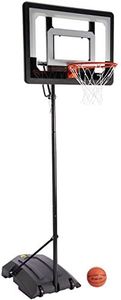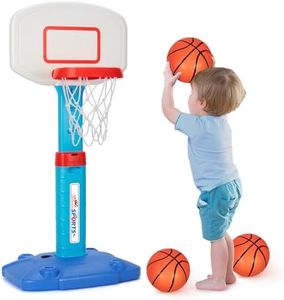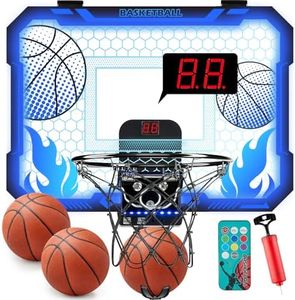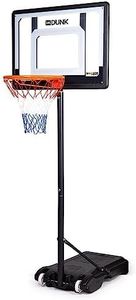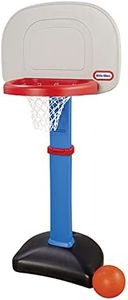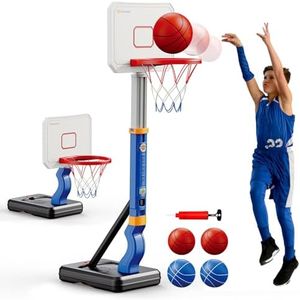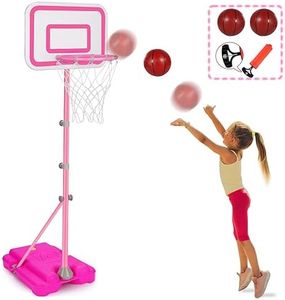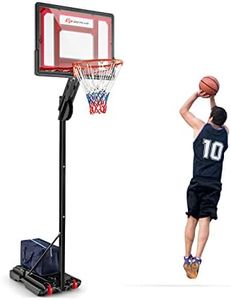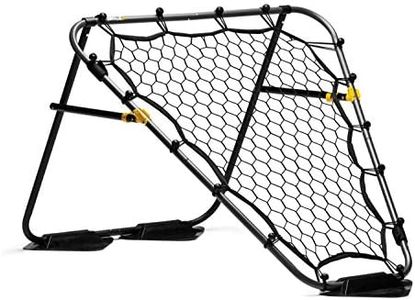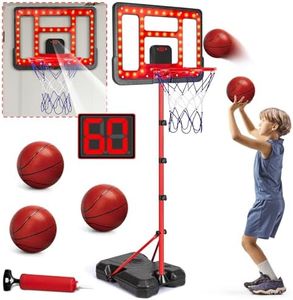We Use CookiesWe use cookies to enhance the security, performance,
functionality and for analytical and promotional activities. By continuing to browse this site you
are agreeing to our privacy policy
10 Best Portable Basketball Hoop For Kids
From leading brands and best sellers available on the web.By clicking on a link to a third party's website, log data is shared with that third party.
Buying Guide for the Best Portable Basketball Hoop For Kids
Choosing a portable basketball hoop for kids is all about balancing safety, durability, and the right features to encourage fun and skill development. Start by thinking about where the hoop will be used (backyard, driveway, indoors) and how old the players are. The right setup should be adjustable for growth, easy to move, and sturdy enough to withstand enthusiastic play. Make sure to prioritize products designed for children, as these will focus more on accessibility and safe construction.Adjustable HeightHeight adjustability lets you raise or lower the hoop as your child grows or gains skill. Most hoops for young kids start around 3-5 feet and can go up to 7 feet or more. For toddlers and young kids (ages 3-7), look for hoops that adjust lower for easier shooting. For older or more experienced children, a hoop that can reach standard heights (up to 10 feet) is better. Your choice should match your child’s age and ability, with enough room to increase the challenge as they improve.
Base Stability and SizeThe base is what keeps the hoop upright and safe during play. Larger bases filled with sand or water make the hoop less likely to tip over. Compact bases are easier to move but might be less stable for active players. For younger kids, smaller bases may be sufficient, but for energetic play or for older children, a larger, heavier base is safer.
Backboard Material and SizeBackboards can be made from plastic, polycarbonate, or acrylic. Plastic is lightweight and best for very young kids. Polycarbonate and acrylic are more durable and give a better ball bounce, which is more fun for older, stronger kids. Backboard size also matters: smaller backboards (around 24 inches) suit toddlers, while larger ones (up to 44 inches) are better for older or more serious players. Choose based on your child's age and their interest in practicing real basketball skills.
PortabilityA portable hoop should be easy to move around your home or driveway. Look for wheels on the base for easier relocation. Lightweight hoops are easier to move but may lack stability. If you plan to move the hoop often or use it in various places, portability will be more important; if it will generally stay in one spot, you can focus more on stability.
Rim TypeThe rim should be safe and appropriate for kids. Fixed plastic rims are common for smaller hoops and younger children. For older kids, metal rims with some flexibility or 'breakaway' action are safer for more aggressive play. Pick a rim that matches your child’s playing style—plastic or fixed for gentle play, and flexible for kids who like to hang on the rim or play tougher.
Assembly and AdjustabilitySome hoops are easier to put together and adjust than others. Look for clear instructions and tools included. If you want a hoop that’s regularly raised or lowered, make sure the adjustment mechanism is simple and safe for adults or even older kids to manage. Consider how often you'll need to assemble, move, or adjust the hoop and choose accordingly- simpler is usually better for busy families.
Weather ResistanceIf the hoop will be used outdoors, its materials should stand up to sun and rain. UV-resistant plastics and rust-resistant metals are best for year-round use outside. If the hoop is mostly for indoor use, this is less important. Think about where and how often the hoop will be outdoors when deciding how weatherproof it needs to be.
